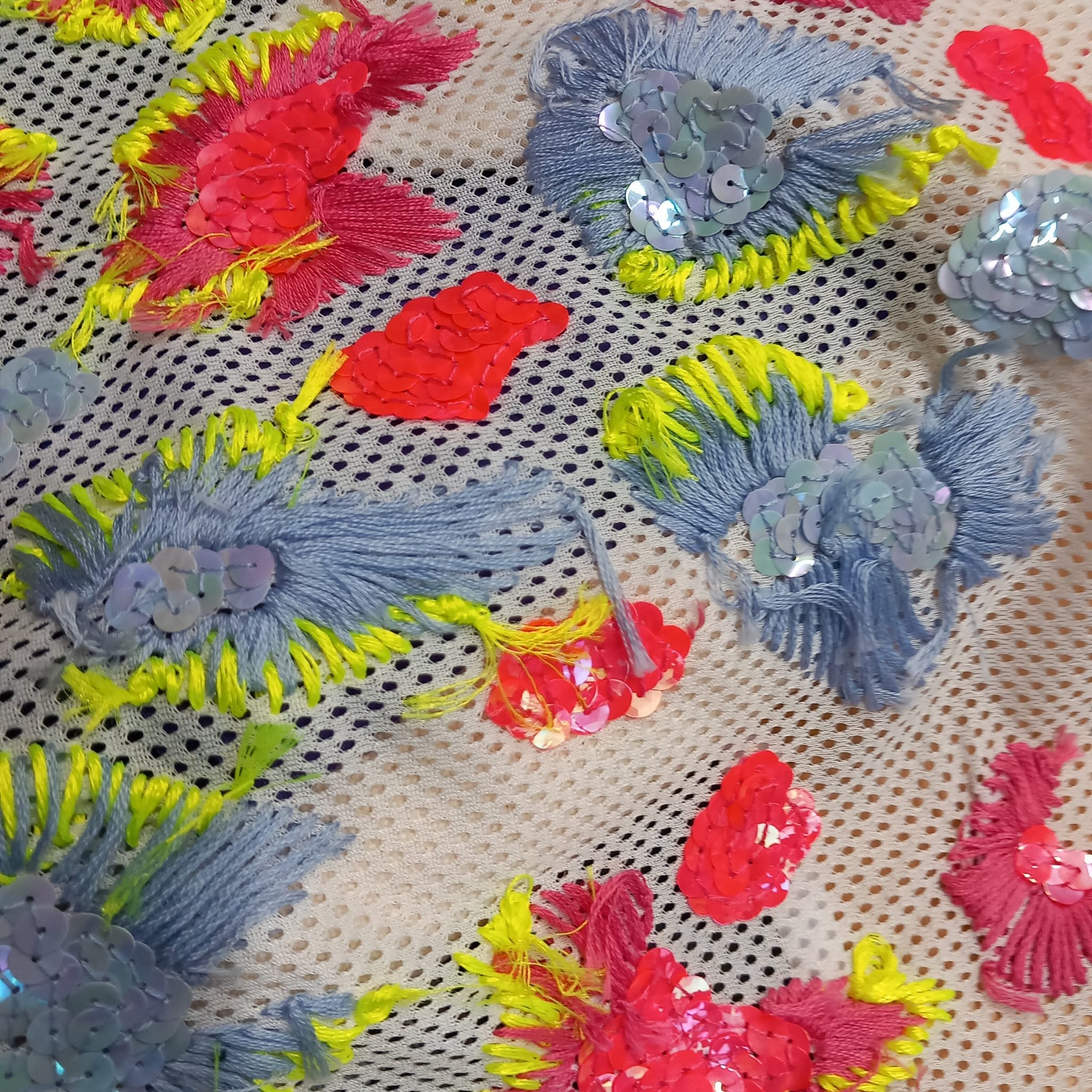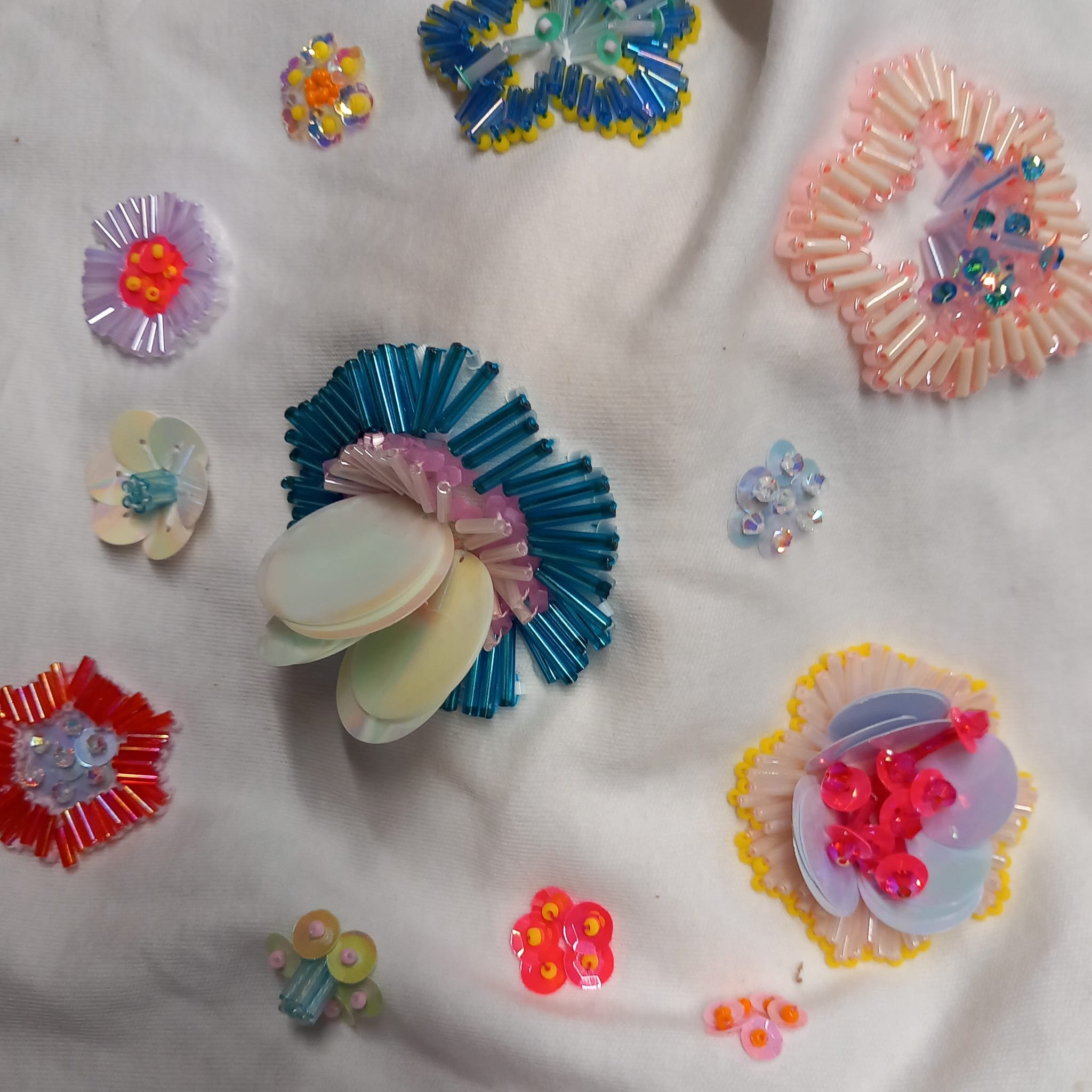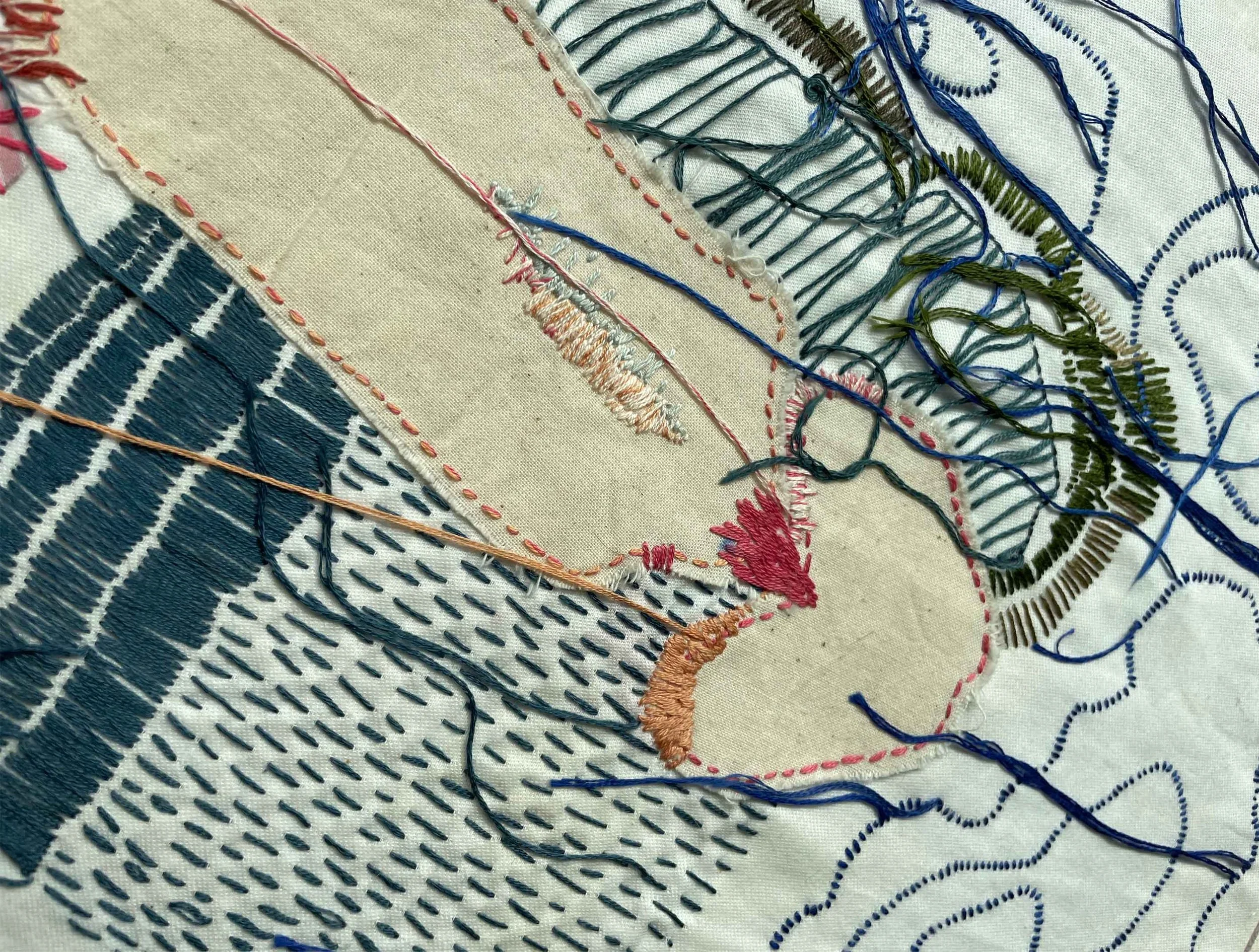
AMID the silent flowers
TERENCE WILDE
Terence Wilde, Amid the Silent Flowers, 42 x 30cm

Sometimes I sew to repair the past, make it bearable.
Often, I embroider to remain in the present.
Mostly I embellish for the sake of beauty.
Terence Wilde
Introduction
This online exhibition marks the end of the first year of the Amid the Silent Flowers Collective. Set up by artist and educator Terence Wilde, he wanted to create a space for queer men and male adjacent to safely explore their experiences and collective histories through reflective conversation and making with threads. The monthly workshops were to provide an opportunity for social connections and the sharing and development of new skills, knowledge, and friendships. It was developed with initial funding from the Responsa Foundation, further funding and support from QUEERCIRLE, and project support throughout from the Jennifer Lauren Gallery.
Scroll on for further information, some of the artwork created, and a new short simple film showing the importance of stitch in this group’s lives. Click on any of the images to make them bigger and to see the details on them.
About the group
A snippet from an essay written by Terence at the end of the first year, reflecting back. You can read the full piece by following the button link below.
“A recent homophobic assault on someone's boyfriend, in Soho in broad daylight. Complaints of intolerance aimed at two mothers with their baby, and a gay couple holding hands in a coffee shop, asked to leave because their behaviour is making a heterosexual family feel uncomfortable. I am sitting at a corner table in Café Nero, having witnessed some of this and I am trying to make myself invisible in case I'm next in the firing line.
I wonder why this hasn't stopped and gone away, why so many of us LGBTQIA+ people still live fearfully within its orbit. It’s 2023 and I continue struggling with the low self-esteem that this type of disgust and hatred has created in many queer people’s lives. I couldn't fight back when I was younger, I had no voice against something so profoundly damaging.
Around this time, I coincidentally received an email from my friend Jennifer from the Jennifer Lauren Gallery, with a “What do you think of this?” callout opportunity for funding. The Responsa Foundation support artists creating work around the many ways artists feel both divided and united in the world. The idea of starting an art and health collective for people identifying as queer men or male adjacent* seemed an ideal opportunity to meet up and explore our experiences and histories… to use our buried voices creatively.
The embroidery-based idea of ‘Amid the Silent Flowers’ was born. A small grant would offer the opportunity to explore queer men's lived experiences through reflective conversation and making. Looking into our queer identities and how we have experienced the world through conversation and stitch could be a way to move on with our lives through deeper connections to our authentic selves.
‘Amid The Silent Flowers’ would provide a series of monthly creative workshops, lightly facilitated by me, using a foundation of embroidery techniques and no previous stitch experience required. The heart and soul of the project would be in creating a safe space. Safety being paramount to the nurturing of queer men, when delving into our inner worlds and personal spaces, often used as retreats and survival mechanisms to cope in hostile environments. The underlying ethos of this type of work is radical in re-addressing how homophobia has affected our lives, particularly our mental health.
Taking a creative approach in looking at how prejudice has caused disharmony within the queer community is radical. It involves acknowledging past LGBTQIA+ history alongside the current perceived freedom of a more gender fluid world. Ownership of gender, sexuality, and the greater choices this now brings to queer men is possible because of the trail blazers, activists, the ghosts of hidden survivors and brave souls working from the edges of society to help give us strength to be ourselves. Allies, regardless of gender have also helped us with our emancipation, particularly women.”
*By the term male adjacent we mean non-binary people who sit close to male on the gender spectrum.

THE USE OF SEQUINS
The collective invited artist Jodie ruffle along to one of their monthly sessions, to run a masterclass in beading and sequin work. Terence said, "it was her fashion work and her using the reverse of her fabrics that spoke to us and inspired us as well. Jodie's approach to working back to front sat perfectly with the element of repair, and is the underbelly of a queer man's ability to be vulnerable and use it as part of our resilience."
THE IMPORTANCE OF STITCH
A new film about the importance of stitch for the Amid the Silent Flowers collective. They share how stitching has altered their lives and given them a focus. This film can be watched full screen by clicking on the arrows.
Also here are two sewing kits from the collective and you will see that they all like to be very organised!

ARTISTS AND ARTWORKS
GLEN
“I am new to it, but it creates a space where you can think about things or meditate over certain ideas. It’s a different process of how you think when you do something with your hands whilst you are thinking, rather than just thinking and doing nothing. When you are doing things with your hands, I find there to be less negative thoughts that come into my head.”
“The symbols in my work are a pigpen cipher. I used this to write secret messages to my friend who was queer at school, many years ago.”
JACK
“When I was at school, the way I got through everything, I just pretended I was straight, and in doing that I subconsciously created a mask that I shared with the world and I hid all those parts with the world but also myself. And what I inadvertently did there was I kind of like created this version of myself that the task of my adult life has been unpicking the difference between who is actually me, and who the mask is.”
MATT
“Working with stitch is something that I’ve always done really, since a really young child. So, it connects me back to my mother who taught me, and the incredibly creative, practical, intelligent women in my family who used craft, made craft, worked with all sorts of stitch and yarn and many things, so it’s a nice connection to that. Working with stitch also allows me to work in a way that is less planned and more organic than a lot of work that I do. Something that I can feel my way, so I don’t worry so much about consistency and it’s more visceral, more about how I am feeling in that moment, with an overview of where I want to go, but something where I seem to allow myself to be more experimental.”
Philip
“When I started at secondary school I was petrified as I thought I was going to be bullied as I was disabled and I was different, so I found escape from the playground everyday by going to the sewing club. I was the only boy who went to the sewing club and it meant I didn’t have to play football with the rough boys. And I didn’t get rained on, so sewing has always been an escape for me… an escape from things that I felt uncomfortable around and I still feel that now really. So, it is nice to come together and sew with people who also wouldn’t want to go and play football with the rough boys. It feels very similar to that.”
Shafiq
“I grew up in a culture where embroidery and stitching was quite a big part of the aesthetic and it was something I was kind of deterred from as a child. That doesn’t mean to say that men were not stitching and embroidering in the culture that I grew up with. So, I think stitching and embroidery means, well I guess it’s like coming full circle, I guess doing something with my own heritage and culture and doing not what was expected of me too. So, there is an element of that too, maybe like a quiet rebellion.”
TERENCE
“Stitch is important because it is deliberate repairing – it is a conscious repairing of other issues, and it’s a metaphor for mending and putting things back together. It doesn’t have to look like anything in particular, you can forge what you want, or forge something you don’t expect or are not expecting, and that is okay... instead of having to follow a particular metric or particular set of instructions.”

Displaying the reverse
The collective became interested in the reverse side of their works, based on Terence's interests around this. He said, “The underside of the embroidery reflects the true nature of the sewer. It holds all of the perceived mistakes and unguarded feelings which are hidden in the finished piece that we present to the world. People see what they want to see on the surface, but it's the underneath that reveals us so profoundly. We used sewing as a way of accepting and healing ourselves, as it resonated so well with our sense of expressed core emotions.”
FINAL THOUGHTS
At the end of the essay Terence writes:
“I feel lighter and better about myself from taking the risk in setting up ‘Amid the Silent Flowers.’ A year ago, a group of random strangers identifying as queer men or male adjacent replied to a callout to meet and stitch together, to explore our experiences and histories through embroidery. The session times were doubled from 2 to 4 hours, and extra workshops were added to the initial eight, to give us more time together. Trips out to sew in café’s became extra-special moments, casting the safety net we made at QUEERCIRCLE further afield. One member even shared photos of feeling safe enough to stitch in a gay bar, allowing for a conversation to be struck up with the bartender who also did embroidery.
I can only speak for myself when I say I am very much amid the flowers, but I am not so silent anymore. It takes a lot more energy to be something you’re not, than something you are.
Thank you.”



































